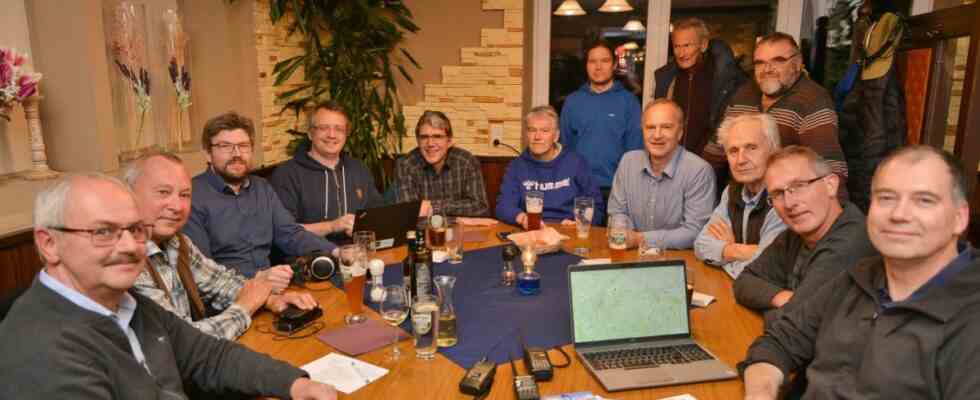It is a foggy winter evening when the German Amateur and Radio Club (DARC) from Ebersberg called “C 24” meets in Gsprait for its monthly local association evening – OVA, the members call it themselves. Many such subject-specific abbreviations are taken for granted on this evening dropped at the table around which 15 of the almost 20 members gathered. Some handheld radios scattered on the table can be seen from afar.
“In addition to the cozy, private sitting together, the technical exchange is in the foreground on such evenings,” says Wilfried Billing, chairman of the local association. The 74-year-old electrical engineer has only been representing the Ebersberg local association since the end of 2022.
Wilfried Billing has held his radio license for almost 50 years, which every amateur radio operator has to apply for from the Federal Network Agency before he can dive into the worldwide radio network. He practiced radio transmission on a Japanese device in his home town in the Upper Palatinate, near the town of Weiden. “Back then, my father and I welded together the tubular masts in the garden and built them up,” he remembers. Like most of the members, he also has his own radio room at home today, in which cables, buttons and fittings are piled up, between which the trained eyes of the radio operators can read their own order.
Currently, most of the communication takes place via the Internet – which could become difficult in the event of a crisis
“But radio operators are more than just hobby amateurs who are enthusiastic about technology,” emphasizes Wolfgang Michalke, former chairman of the local association. The majority of the population currently relies entirely on the Internet for communication. And in fact, for most young people, the larger handheld radios would probably be indistinguishable from an old mobile phone at first glance: black, touchscreen-free plastic boxes with an extendable antenna swinging on top.
But the one-way communication process via smartphones creates a dependency that could prove fatal in a natural disaster. “If everyone suddenly tries to make phone calls and make contact in a disaster scenario, then the Internet buckles. Emergency care is then no longer guaranteed,” says Markus Kandlbinder. The 58-year-old patent attorney is committed to providing communication services in the district in emergencies. In such situations, it makes sense to use the radio.
In order to wirelessly network emergency facilities such as hospitals, police stations, the fire brigade or district offices, the network nodes first have to be installed on the roofs of the facilities. This would allow the facilities to contact the members of the DARC by radio in the event of a “blackout”. These, in turn, could then send an emergency call to the DARC or to radio-capable emergency facilities in the nearest Internet-connected location, so that emergency care could be coordinated from there via the mobile network. The scenario during the flood disaster in the Ahr valley was similar for a hospital whose mobile phone connection was broken by the flood.
The Ebersberg radio operators have many plans
A long communication path, in which a lot of responsibility lies with the radio operators, who hopefully do not twist information between the individual stations according to the silent message principle. The first facility to be equipped with such a network node in Ebersberg is the district office. The community centers, fire brigade and possibly also the police should then follow, says Markus Kandlbinder. Of course, all this will take a while.
70 percent of Germany are now covered by the so-called “Hamnet”. “The Hamnet is actually exactly the same as the Internet, just for radio operators,” explains Kandlbinder. Three so-called light paths, via which the radio connections are established, branch off from the Ebersberg observation tower in different directions. Radio signals are received and forwarded there. “The optimization of the light paths is also one of our current projects.”
Radio amateurs confirm a successful connection by sending a QSL card. The Ebersberg radio operators have already collected some of them.
(Photo: Christian Endt)
Regardless of language and country, radio signals would not be stopped by geographic borders. The German association is networked with radio operators from all over the world and maintains contacts in all directions. Even connections to very remote areas abroad are established regularly. As proof of this, Wilfried Billing spreads out a stack of postcard-sized pictures on the round wooden table.
So-called QSL cards are sent to each other as confirmation of a successfully established radio connection. These then contain the location, date, time and other background information about the radio call. But beyond the technical exchange, one makes personal contacts abroad. “For example, there is a radio amateur in Tromsø with whom I have developed a personal relationship,” says Wilfried Billing. The contact developed so well that a few years ago he traveled to Norway with his wife in a camper van to visit him.

